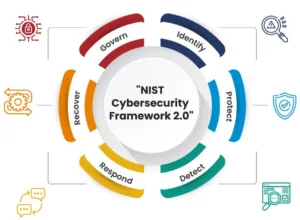
Discover how the power of data governance is unleashed to safeguard your digital world. Explore the strategies and insights ensuring robust privacy and security in today’s digital age.
Table of Contents
Introduction
In the contemporary digital age, ensuring data privacy and security takes precedence. With the rapid advancement of technology and the increasing reliance on digital platforms, the volume of sensitive information being generated, stored, and transmitted has grown exponentially. This has heightened the significance of safeguarding this data from various threats.
One of the most pressing concerns is the alarming rise in data breaches and cyber threats. These breaches can have severe consequences, ranging from financial losses and reputational damage to legal liabilities. Cyber threats, on the other hand, encompass a wide range of malicious activities, including hacking, phishing, malware attacks, and ransomware. They constantly evolve and pose a continuous risk to organizations and individuals alike.
Data governance is a comprehensive framework and set of practices that organizations employ to manage their data effectively. It encompasses a structured approach to data management, ensuring that data is handled consistently, securely, and in accordance with established policies and controls.
Significance of Data Governance
Data governance holds immense significance in today’s data-driven world for several reasons:
1. Data Quality: It ensures the accuracy, consistency, and reliability of data, which is essential for informed decision-making and trustworthy business operations.
2. Compliance: Data governance helps organizations adhere to data protection regulations and industry standards, reducing the risk of legal and financial penalties.
3. Risk Mitigation: It identifies and mitigates data-related risks, such as data breaches, unauthorized access, and data loss, safeguarding sensitive information.
4. Data Transparency: Data governance promotes transparency in data management, making it easier for stakeholders to understand data sources, usage, and lineage.
5. Efficiency: By establishing clear policies, processes, and controls, data governance streamlines data management practices, reducing redundancy and inefficiency.
6. Data Ownership: It assigns responsibility for data to specific individuals or teams, ensuring accountability for data accuracy and security.
7. Data Lifecycle Management: Data governance covers the entire data lifecycle, from creation and storage to archiving and disposal, ensuring data remains relevant and secure throughout.
Policies, Processes, and Controls
Data governance involves the following key components:
1. Policies: These are documented rules and guidelines that dictate how data should be handled, including who has access, how data is classified, and retention periods.
2. Processes: These are structured workflows and procedures that define how data is collected, stored, processed, and shared within an organization. Processes ensure consistency and adherence to policies.
3. Controls: Controls are mechanisms put in place to enforce policies and maintain data integrity and security. Examples include access controls, encryption, and auditing. In essence, data governance provides the framework for organizations to manage their data as a valuable asset, ensuring it is used effectively, protected from threats, and aligned with business goals and compliance requirements.
The Link Between Data Governance, Data Privacy, and Security
Data governance, data privacy, and data security are intrinsically connected in today’s digital landscape. Data governance forms the foundation upon which data privacy and security efforts are built. It plays a pivotal role in identifying and protecting sensitive data.
Here’s how:
1. Clear Data Classification:
– Data governance defines clear data classification and categorization standards.
– This classification helps in identifying sensitive data, such as personal information, financial records, or proprietary business data.
2. Access Control Policies:
– Data governance establishes access control policies and user permissions.
– These policies ensure that only authorized individuals or systems can access and modify sensitive data.
3. Data Lifecycle Management:
– Effective data governance includes guidelines for data lifecycle management, including data retention and disposal.
– By managing the data lifecycle, organizations can prevent data leaks or breaches when sensitive data is no longer needed.
4. Data Encryption:
– Data governance may mandate encryption standards for sensitive data.
– Encryption ensures that even if unauthorized access occurs, the data remains unintelligible to those without the decryption keys.
5. Data Auditing and Monitoring:
– Data governance often includes auditing and monitoring processes.
– These processes track data access and changes, helping detect suspicious activities or unauthorized data handling.
6. Data Privacy Compliance:
– Data governance aligns with data privacy regulations (e.g., GDPR, HIPAA) and ensures that data handling practices comply with these laws.
– Compliance with data privacy regulations is a critical component of data governance.
Risk Assessment and Mitigation in Data Governance
Risk assessment and mitigation are fundamental components of data governance that play a critical role in ensuring the security and privacy of data.
Here’s how these processes work within the framework of data governance:
1. Risk Assessment:
– Risk assessment involves a systematic evaluation of potential vulnerabilities, threats, and risks related to data.
– Data governance teams identify and analyze various factors that could jeopardize the confidentiality, integrity, or availability of data.
– This process often includes assessing the impact of potential risks on the organization, its reputation, compliance with regulations, and financial stability.
2. Vulnerability Identification:
– Data governance teams work to identify vulnerabilities within the organization’s data infrastructure.
– Vulnerabilities could be technical (e.g., software weaknesses), procedural (e.g., poor data handling practices), or human-related (e.g., lack of security awareness among employees).
3. Threat Analysis:
– Data governance professionals analyze potential threats to the organization’s data, including cyber threats like hacking, malware, and insider threats.
– They consider external and internal threats that could exploit vulnerabilities and compromise data security.
4. Risk Quantification:
– After identifying vulnerabilities and threats, data governance teams assess the likelihood and potential impact of each risk.
– This quantification helps prioritize risks and allocate resources effectively to mitigate them.
5. Mitigation Strategies:
– Once risks are identified and quantified, data governance teams develop and implement mitigation strategies.
– These strategies may include security measures like encryption, access controls, regular software patching, employee training, and incident response plans.
6. Proactive Approach:
– Data governance emphasizes a proactive approach to risk mitigation.
– Rather than waiting for security incidents to occur, organizations continuously monitor, assess, and update their mitigation strategies to stay ahead of emerging threats.
7. Compliance Alignment:
– Data governance ensures that risk mitigation strategies align with regulatory requirements.
– Compliance with data protection laws often involves specific security measures, and data governance ensures these are integrated into the organization’s risk mitigation efforts.
8. Incident Response Planning:
– Data governance includes the development of incident response plans.
– These plans outline how the organization will respond to security incidents, minimizing their impact and preventing data breaches from escalating. Risk assessment and mitigation are integral to data governance’s mission of safeguarding data privacy and security.
By systematically identifying vulnerabilities, assessing threats, and proactively implementing mitigation measures, organizations can reduce the likelihood and impact of data breaches, cyberattacks, and other security incidents. This proactive approach helps protect sensitive data and maintain the trust of stakeholders.
Data Incident Response
Data governance incorporates specific protocols and procedures for responding to data breaches or security incidents. Having a well-defined incident response plan is a fundamental aspect of data governance, and it plays a crucial role in minimizing the impact of security incidents.
Here’s how data incident response functions within the framework of data governance:
1. Rapid Detection and Reporting:
– Data governance emphasizes the importance of early detection and reporting of data breaches or security incidents.
– Employees are trained to recognize potential incidents and know how to report them promptly.
2. Incident Assessment:
– When an incident is reported, data governance teams assess its scope, severity, and potential impact.
– This assessment helps determine the appropriate level of response required.
3. Notification and Escalation:
– Data governance protocols define who needs to be notified within the organization.
– Incidents are escalated to the appropriate personnel, including incident response teams and senior management.
4. Incident Containment:
– Once an incident is confirmed, the response plan outlines steps for containing the incident to prevent further damage or data exposure.
– Containment measures may involve isolating affected systems, disabling compromised accounts, or implementing network controls.
5. Root Cause Analysis:
– Data governance teams conduct a root cause analysis to determine how the incident occurred and identify vulnerabilities that may have been exploited.
– Understanding the root cause is essential for preventing similar incidents in the future.
6. Data Recovery and Restoration:
– Response plans include procedures for data recovery and system restoration.
– Data governance ensures that data is restored from secure backups, minimizing data loss.
7. Communication and Notification:
– Data governance defines communication protocols for notifying affected parties, which may include customers, employees, regulatory authorities, and the public.
– Transparent communication is essential for maintaining trust and compliance with data protection laws.
8. Legal and Compliance Considerations:
– Data governance incorporates legal and compliance aspects into the response plan.
– This includes considerations related to data breach notification laws and regulatory reporting requirements.
9. Documentation and Lessons Learned:
– After the incident, data governance teams document the entire response process.
– Lessons learned are analyzed to improve incident response procedures and overall security measures.
10. Continuous Improvement:
– Data governance encourages a culture of continuous improvement in incident response. – Organizations use insights from previous incidents to refine response plans, bolster security measures, and enhance overall data governance practices.
Data Ownership and Accountability
Data governance places a strong emphasis on data ownership and accountability within organizations. These principles ensure that individuals or teams are responsible for safeguarding sensitive data and managing it in accordance with established policies and procedures.
Here’s how data ownership and accountability work within the framework of data governance:
1. Data Ownership:
– Data governance assigns ownership of specific data assets to individuals or departments within the organization.
– Data owners are responsible for overseeing the quality, security, and appropriate use of the data under their purview.
– Data ownership ensures that there is a clear point of contact for each dataset, facilitating efficient data management and decision-making.
2. Data Stewardship:
– Data stewards are individuals or teams responsible for the day-to-day management and maintenance of data assets.
– They work closely with data owners to ensure data integrity, accuracy, and compliance with data governance policies.
– Data stewards play a critical role in executing data governance initiatives.
3. Accountability for Data Security:
– Data governance assigns accountability for data security to relevant personnel or teams.
– These individuals are responsible for implementing security measures, access controls, and encryption to protect sensitive data from unauthorized access and breaches.
4. Compliance Responsibilities:
– Data governance ensures that individuals or teams accountable for data assets are aware of and adhere to data privacy regulations and compliance requirements.
– They oversee data handling practices to ensure compliance with laws like GDPR, HIPAA, or industry-specific regulations.
5. Data Lifecycle Management:
– Owners and stewards are responsible for managing the entire data lifecycle, including data creation, storage, retention, archiving, and disposal.
– They ensure that data is handled consistently throughout its lifecycle.
6. Access Control:
– Data owners and stewards are responsible for defining and implementing access control policies.
– They determine who has access to data assets and at what level, ensuring that sensitive data is protected from unauthorized users.
7. Data Quality Assurance:
– Those responsible for data assets also oversee data quality and accuracy.
– They implement measures to validate and cleanse data, ensuring that it remains reliable and trustworthy.
8. Incident Response:
– In the event of a data security incident, data owners and stewards play a key role in coordinating the incident response efforts and ensuring that proper remediation steps are taken.
9. Collaboration and Communication:
– Data owners and stewards collaborate with other stakeholders, including IT teams, legal, compliance officers, and business units.
– Effective communication and collaboration are essential for successful data governance.
In summary, data ownership and accountability are foundational principles in data governance that ensure that specific individuals or teams are responsible for safeguarding sensitive data, maintaining data quality, and complying with data governance policies and regulations. These principles contribute to the effective management, security, and privacy of an organization’s data assets.
Key Principles of Data Governance
Data governance is built upon a set of core principles that guide organizations in managing their data effectively, securely, and in compliance with regulations.
Some of the key principles include:
1.Data Classification:
– Data should be classified based on its sensitivity and importance to the organization.
– Data classification involves labelling data as “public,” “confidential,” “sensitive,” etc., to determine appropriate handling and protection measures.
– This principle helps organizations identify and prioritize sensitive data, which is crucial for data privacy and security efforts. It ensures that the highest level of protection is applied to the most critical data assets.
2. Access Control:
– Access to data should be controlled and restricted according to predefined policies and user roles.
– Access control ensures that only authorized individuals or systems can view, modify, or delete data.
– By implementing strong access control measures, organizations can prevent unauthorized access and protect data from breaches, enhancing both data privacy and security.
3. Data Lifecycle Management:
– Data should be managed throughout its lifecycle, from creation to disposal.
– Data governance defines processes for data retention, archival, and secure deletion.
– Effective data lifecycle management reduces the risk of data exposure and breaches by ensuring that data is only retained as long as necessary, and it’s securely disposed of when no longer needed.
4. Data Quality and Accuracy:
– Data governance emphasizes the importance of data quality and accuracy.
– It defines standards for data validation, cleansing, and maintenance.
– Ensuring data accuracy is crucial for making informed decisions and maintaining trust, while data quality also impacts data security by reducing the likelihood of errors leading to security vulnerabilities.
5. Data Privacy Compliance:
– Data governance aligns with data privacy regulations and industry standards.
– It includes policies and practices that ensure data handling complies with legal requirements.
– Compliance with data privacy regulations, such as GDPR or HIPAA, is critical for protecting individual privacy and avoiding regulatory penalties.
6. Data Ownership and Accountability:
– Data governance assigns ownership and accountability for data assets.
– Individuals or teams are responsible for data stewardship, including data protection and quality assurance.
– Clearly defined data ownership helps ensure that someone is accountable for data privacy and security within the organization.
7. Data Security:
– Data governance incorporates security measures such as encryption, authentication, and intrusion detection.
– Security practices protect data from unauthorized access, breaches, and cyber threats.
– Data security is integral to safeguarding sensitive information and maintaining the confidentiality and integrity of data.
These core principles of data governance collectively contribute to data privacy and security by establishing a structured framework for data management. They help organizations identify, protect, and govern their data assets effectively, ensuring that sensitive information is handled securely, compliantly, and with a focus on data privacy and security best practices.
Best Practices for Implementing Data Governance
Implementing effective data governance is crucial for enhancing data privacy and security.
Here are some practical tips and best practices for organizations looking to strengthen their data governance initiatives in order to improve data privacy and security:
1. Define Clear Data Governance Goals:
– Begin by establishing clear and specific data governance objectives. Identify what you aim to achieve with your data governance program, such as improving data privacy, enhancing data security, or ensuring regulatory compliance.
2. Appoint Data Governance Champions:
– Assign dedicated data governance leaders or champions within your organization. These individuals should have the authority and responsibility to drive data governance initiatives forward.
3. Develop Comprehensive Data Policies:
– Create comprehensive data policies that cover data classification, access controls, data retention, and data handling procedures. Ensure that these policies align with your data governance goals and regulatory requirements.
4. Data Classification and Sensitivity:
– Implement a data classification system that categorizes data based on its sensitivity and criticality. This helps prioritize data protection efforts and ensures that sensitive data receives the highest level of security.
5. Data Mapping and Inventory:
– Maintain an up-to-date inventory of all data assets, including their locations and owners. Use data mapping techniques to understand how data flows within your organization.
6. Access Control and Authorization:
– Enforce strong access controls and authorization mechanisms to limit data access to authorized users only. Implement role-based access control (RBAC) and regularly review and update user permissions.
7. Data Encryption:
– Implement encryption for sensitive data both at rest and in transit. Encryption helps protect data even if unauthorized access occurs.
8. Data Privacy Impact Assessments (DPIA):
– Conduct DPIAs to assess the impact of data processing activities on privacy. This is especially important for compliance with data protection regulations like GDPR.
9. Data Security Training:
– Provide regular training and awareness programs to educate employees about data security best practices, the importance of data privacy, and their role in safeguarding data.
10. Incident Response Plan:
– Develop a robust incident response plan that outlines how to detect, respond to, and recover from data security incidents or breaches. Regularly test and update this plan.
11. Compliance Monitoring:
– Continuously monitor and audit data governance practices to ensure compliance with relevant laws and regulations, such as GDPR, HIPAA, or industry-specific standards.
12. Data Governance Tools:
– Consider investing in data governance tools and technologies that facilitate data discovery, monitoring, and compliance management.
13. Communication and Collaboration:
– Foster collaboration between data governance teams, IT, legal, compliance, and business units. Effective communication is vital for the success of data governance initiatives.
14. Data Retention and Disposal:
– Establish data retention policies that specify how long data should be kept and when it should be securely disposed of. Outdated or unnecessary data can pose security risks.
15. Regular Assessments and Improvement:
– Periodically assess the effectiveness of your data governance program and make necessary improvements based on lessons learned and changing threats.
16. External Expertise:
– Consider seeking external expertise or consulting services to ensure your data governance program aligns with industry best practices and regulations.
By following these best practices and tailoring them to your organization’s specific needs and industry regulations, you can strengthen your data governance initiatives, enhance data privacy and security, and build a culture of responsible data management.
Conclusion:
In today’s data-driven world, the role of data governance in data privacy and security cannot be overstated. A robust data governance framework serves as the cornerstone for safeguarding sensitive data, ensuring its confidentiality, integrity, and availability.
Here are the key takeaways:
1. Foundation for Protection: Data governance forms the foundation upon which data privacy and security efforts are built. It provides structure, policies, and controls for managing data effectively.
2. Identification and Prioritization: Through data governance, organizations can identify and prioritize sensitive data, ensuring that it receives the highest level of protection.
3. Risk Mitigation: Data governance includes risk assessment and mitigation strategies to proactively identify and address security threats, reducing the likelihood and impact of incidents.
4. Compliance and Accountability: It ensures compliance with data privacy regulations and assigns ownership and accountability for data assets, making individuals or teams responsible for data protection.
5. Incident Response: Data governance includes incident response planning, enabling organizations to respond swiftly and effectively to security incidents, minimizing their impact.
6. Data Quality: Data governance emphasizes data quality and accuracy, reducing the risk of errors that could lead to security vulnerabilities.
7. Continuous Improvement: Organizations are encouraged to adopt a culture of continuous improvement in data governance practices, learning from incidents and refining strategies.
8. Communication and Collaboration: Collaboration between data governance teams, IT, legal, and other stakeholders is essential for successful data privacy and security efforts.
9. Comprehensive Policies: Organizations should develop comprehensive data policies that cover data classification, access controls, retention, and handling procedures, aligning them with data governance goals.
In conclusion, a robust data governance framework is not just a best practice; it is a necessity in today’s digital landscape. It ensures that organizations can manage their data responsibly, protect sensitive information, comply with regulations, and effectively respond to security incidents. By prioritizing data governance, organizations can build a resilient defense against data breaches and cyber threats while maintaining the trust of stakeholders. The increasing sophistication of cyberattacks, coupled with the potential for far-reaching consequences, underscores the urgent need for robust data privacy and security measures.
Protecting personal, financial, and proprietary data is not only a legal and ethical obligation but also a crucial aspect of maintaining trust in the digital age. Organizations and individuals must proactively address these concerns to ensure the confidentiality, integrity, and availability of their sensitive data.
Read more on https://cybertechworld.co.in for insightful cybersecurity related content.




















Your point of view caught my eye and was very interesting. Thanks. I have a question for you.
Thanks for the diverse tips discussed on this web site. I have seen that many insurance providers offer consumers generous discounts if they elect to insure more and more cars together. A significant number of households own several automobiles these days, especially those with mature teenage children still living at home, as well as the savings in policies can soon mount up. So it makes sense to look for a great deal.
What an insightful and thoroughly-researched article! The author’s attention to detail and capability to present intricate ideas in a comprehensible manner is truly admirable. I’m thoroughly impressed by the scope of knowledge showcased in this piece. Thank you, author, for providing your expertise with us. This article has been a game-changer!
As I web-site possessor I believe the content material here is rattling excellent , appreciate it for your hard work. You should keep it up forever! Best of luck.